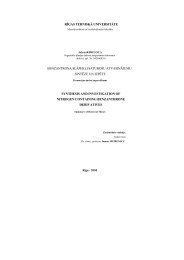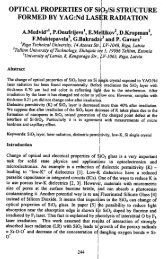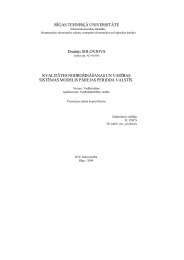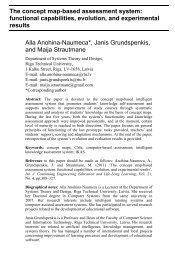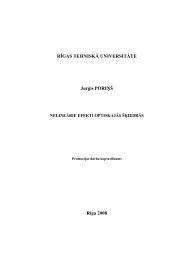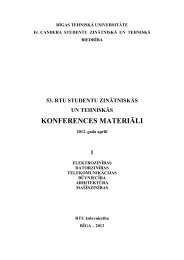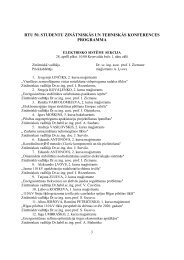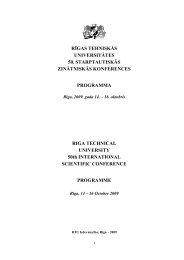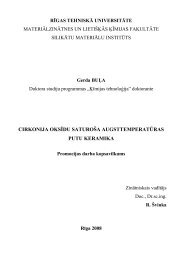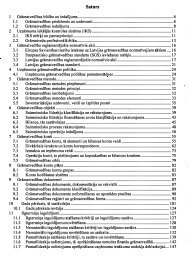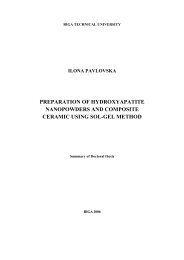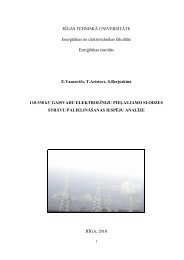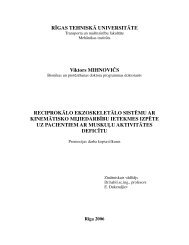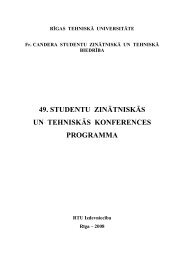RIGA TECHNICAL UNIVERSITY Faculty of Transport ... - Aleph Files
RIGA TECHNICAL UNIVERSITY Faculty of Transport ... - Aleph Files
RIGA TECHNICAL UNIVERSITY Faculty of Transport ... - Aleph Files
- No tags were found...
Create successful ePaper yourself
Turn your PDF publications into a flip-book with our unique Google optimized e-Paper software.
Development and Application <strong>of</strong> Metamodeling Methods for Analysis and Optimization <strong>of</strong> Mechanical Systemsthe number <strong>of</strong> required runs (experimental points) is minimized, and theirdistribution is such that the information obtained from the experiments is ascomplete as possible. Computer experiments, in contract to traditional physicalexperiments, do not have random error since repeated observations with anunchanged input set give identical responses. The design <strong>of</strong> computerexperiments is based on two basic principles, which for the first time wereformulated in 1977 by the RTU (then RPI) scientist Vilnis Eglajs:• Designs do not require more than one observation for a given inputset.• Experimental points must be distributed as uniformly as possible inthe experimental region.Modern design <strong>of</strong> computer experiments <strong>of</strong>ten is conducted using LatinHypercube (LH) designs that are optimized according to some space fillingcriteria. As <strong>of</strong> this moment, the literature does not present results thatconclusively prove the superiority <strong>of</strong> any single criterion. However manyauthors believe that the maximum entropy and distance-based criteria give thebest results [Jin et al. (2001)], [Santner et al. (2003)], [Bursztyn and Steinberg(2006)]. Popular space filling criteria that are not based on a previousassumption <strong>of</strong> the input-output functional form are the MaxiMin, MSE,Discrepancy, Entropy and Eglajs criteria. A significant amount <strong>of</strong> literatureexists on the optimization <strong>of</strong> experimental designs without constraints on levelsaccording to the MaxiMin and MSE criteria, while the LH design optimizationalgorithms have received significantly less attention.Regression analysis employs two different approaches [Härdle (1990)]:parametric approximation and nonparametric approximation. Computerexperiments, in contrast to traditional physical experiments, do not have randomerror, therefore approximation <strong>of</strong> computer experiments should employ methodsthat interpolate experimental data. The most popular methods for computerexperiment approximation are Gaussian process regression (GPR) or kriging(see [Barton (1998)], [Booker (1998)], [Currin 1991], [Sacks (1989)],[Rassmussen and Williams (2006)]), Locally Weighted Polynomialapproximations or Moving Least Squares (see [Cleveland (1979)], [Levin(1998)], [Fan and Gijbels (1996)] etc.), Radial Basis Functions [Dyn (1986)],[Powell (1987)], Neuron Networks (see [Cheng and Titterington 1994], [Haykin1994], Smith and Mistree (1993)], Support Vector Regression [Clarke et al.(2005)], etc. In practice, approximations <strong>of</strong> numerical experiments do not alwaysgo directly through the experimental points. Frequently Response SurfaceMethods (RSM), are employed although from the point <strong>of</strong> view <strong>of</strong> statistics thisapproach is not completely correct.Kriging is a popular computer experiment approximation method. Kriging isbased on the Bayesian approach in statistics and is well suited to the processing<strong>of</strong> determined computer experiments for an average number <strong>of</strong> input factors. Thekriging method generates all possible Gaussian process realizations with a givenDevelopment and Application <strong>of</strong> Metamodeling Methods for Analysis and Optimization <strong>of</strong> Mechanical Systemsmean value and covariance function. The realizations that do not correspond toexperimental data are discarded [Rasmussen and Williams (2006)].To employ kriging method in practice, the parameters <strong>of</strong> the covariancefunction must be determined. The scientific literature considers two methods:Cross-Validation (CV) and the Maximum Likelihood Method (MLL), the mostfrequently used method for hyperparameter determination is the MLL method.Despite the vast amount <strong>of</strong> various approximation methods, there is noconsensus in the scientific literature on which <strong>of</strong> the methods is the best.Recommendations are given in some studies depending on the problem scope,response non-linearity and amount <strong>of</strong> experiments.Inverse engineering problems are solved in cases when model parameters areto be determined on the basis <strong>of</strong> data obtained in experiments. In practice, suchtasks are solved, using the Mixed Numerical–Experimental Techniques(MNET). In this method, the solutions <strong>of</strong> the inverse task are the modelparameters for which the least difference exists between the physical and thenumerical experiment. In the engineering practice <strong>of</strong> the last two decades,MNET methods have been used for parameter identification tasks in variousfields: engineering mechanics, to identify heat conductivity [Trujillo et al.(1997)], determine acoustic [Panneton et al. (2003)], damping [De Visscher(1995)], [Tudor (2003)], plasticity [Furukwaw and Yagawa (1998)], [Yoshida(2003)] properties, in civil engineering, to identify soil permeability [Javadi et al(1999)] and elasticity properties [Hikawa et al. (2004)], in electrical engineeringto identify piezoelectric properties [Ferin G. (2004)], in biomedicine todetermine the mechanical properties <strong>of</strong> skin [Hendriks et al. (2003)] and liver[Kauer (2001)]. The basic problems that have to be solved when employing theMNET approach are: the inaccuracies <strong>of</strong> the mathematical model and theexistence <strong>of</strong> several alternative solutions.In the end <strong>of</strong> this chapter, the dissertation thesis objectives and tasks areformulated.The second chapter proposes an optimization algorithm for LatinHypercube experimental designs. Its application for LH experiment optimizationis described. Figure 2 shows the block diagram for the proposed LHexperimental design optimization algorithm.The experimental design optimization algorithm was used for LH experimentoptimization according to the MSE and MaxiMin criteria.For the optimization <strong>of</strong> experimental designs without LH constraintaccording to the MSE criterion, the so-called NTLBG algorithm exists, whichallows optimization process to converge to the local minimum. In order tooptimize LH experimental designs according to the MSE criterion, the NTLBGalgorithm was modified so that for each cyclic coordinate change it was checkedwhether by reducing the level <strong>of</strong> a given factor for two runs, the distance fromthe experimental points to the mean value <strong>of</strong> the supporting point group for eachexperimental point was reduced.1112
Development and Application <strong>of</strong> Metamodeling Methods for Analysis and Optimization <strong>of</strong> Mechanical Systemslow accuracy and therefore the method may give bad solutions. For many tasks,the number <strong>of</strong> responses can be increased, and it is shown that theambiguousness disappears even if each <strong>of</strong> the responses individually is nonlinearwith non unique inverse relation. In practice, it is <strong>of</strong>ten possible to increase thenumber <strong>of</strong> the measured responses (greater than the number <strong>of</strong> identifiableparameters), therefore there is reason to believe that this drawback <strong>of</strong> inversemetamodeling is not particularly significant for most practical tasks. Ambiguousinverse relation may indicate an error in measurements, in the mathematicalmodel or a possibility that the problem may exist in the formulation <strong>of</strong> the task.Natural experimentsy+eModel parametersxMathematical modelg=f(x)Development and Application <strong>of</strong> Metamodeling Methods for Analysis and Optimization <strong>of</strong> Mechanical Systemscovariance function parameters were determined in two ways. In the firstapproach, m+1 (m – number <strong>of</strong> factors) hyperparameters were determined: onepower hyperparameter and m distance deviation hyperparameters (distancedeviation hyperparameters that correspond to each input factor). In the secondapproach, two hyperparameters were determined: power hyperparameter p andone distance deviation hyperparameter that is common to all the input factors.For almost all <strong>of</strong> the test tasks, the best approximation accuracy was obtainedusing the CV criterion and determining m distance deviation hyperparameters.In this chapter, the accuracy <strong>of</strong> kriging approximations was compared fortwo, three and 5 factor test tasks with first and second order polynomial andlocally weighted first and second order polynomial approximations. For thekriging covariance function, m+1 hyperparameters were determined using theCV criterion. It was concluded that in the majority <strong>of</strong> two factor tasks and in all<strong>of</strong> the considered three and 5 factor test tasks the kriging method gives higherapproximation accuracy (see Figure 4).140120a140120bInverse metamodelx=z(g)x+e=z(y+e)Figure 3. Scheme for the inverse metamodeling method10080604020100806040Second, it is impossible to plan the calculated responses, therefore whencreating inverse metamodels the experimental points do not uniformly cover theresearch region. For this reason, one must deal with singular matrices, by usingpolynomials for approximation whose coefficients are determined with the leastsquares method. For this case the quasi-inversed matrix approach with SingularValue Decomposition method is recommended.The inverse metamodeling method, in contrast to the discrepancy method,allows directly evaluate the quality <strong>of</strong> the solution by determining the accuracy<strong>of</strong> the metamodel, using the cross-validation. The estimation <strong>of</strong> the quality <strong>of</strong>inverse solutions is very significant in practical tasks. The second mainadvantage <strong>of</strong> inverse metamodeling is the fact that, using polynomialapproximations, it is possible to directly evaluate the influence (significance) <strong>of</strong>the various outputs on the inputs.The fourth chapter tests the proposed experimental design andapproximation methods, using various 2, 3 and 5 factor test tasks for variousnumbers <strong>of</strong> experimental points. Test functions described in the literature wereused to compare the effectiveness <strong>of</strong> the CV and MLL criteria for thedetermination <strong>of</strong> covariance function hyperparameters. Approximations for alltest functions were made using both the CV and the MLL method. The0Kvad. lok. pol Lin. lok. pol. Kvad. pol. Kub. pol Kriging200Kvad. lok. pol Lin. lok. pol. Kvad. pol. KrigingFigure 4. Comparison <strong>of</strong> test function approximations, using various methods and variousnumbers <strong>of</strong> points (figure a – 3 factor test tasks, figure b – 5 factor test tasks)In the fifth chapter, the developed methods <strong>of</strong> design <strong>of</strong> experiments,approximation and s<strong>of</strong>tware were applied for the solution <strong>of</strong> practicalengineering design problems – optimization <strong>of</strong> sandwich panels and theidentification <strong>of</strong> elasticity parameters for thin-wall composite constructionelements.The first <strong>of</strong> the considered practical problems is the approximation andoptimization <strong>of</strong> the strength calculations <strong>of</strong> metal I, C, O, Oc, Z and V type coresandwich panels (see Figure 5).1516
Development and Application <strong>of</strong> Metamodeling Methods for Analysis and Optimization <strong>of</strong> Mechanical SystemsDevelopment and Application <strong>of</strong> Metamodeling Methods for Analysis and Optimization <strong>of</strong> Mechanical Systemshyperparameters for each factor and using the CV criterion for the evaluation <strong>of</strong>the accuracy <strong>of</strong> approximation prediction (see Figure 7).10864Figure 5. Schemes <strong>of</strong> metal sandwich panels <strong>of</strong> various core typesFor the design <strong>of</strong> numerical experiments, a 6 factor LH experimental designwas employed that was optimized according to the MSE criterion, using thealgorithm proposed in the second chapter. For the creation <strong>of</strong> the metamodel,250 experimental points were used and other 250 experimental points were usedfor the validation <strong>of</strong> the obtained metamodels. The numerical experiments for allpr<strong>of</strong>ile type sandwich panels were conducted in cooperation with the leadingresearcher <strong>of</strong> the RTU Institute <strong>of</strong> Materials and Constructions Kaspars Kalnins,creating the finite element model using the ANSYS s<strong>of</strong>tware (see Figure 6). Thepanels were loaded with a uniformly distributed 3 kPa load, supplementing itwith concentrated 1kN force in the center <strong>of</strong> the panel.20Kriging Glob. pol. Lok. pol.Figure 7. Approximation error for various responses for the I core panel in 250 test points,using kriging, polynomial and locally weighted polynomial approximationsIt was determined that the quality <strong>of</strong> approximation <strong>of</strong> the sandwich panelplate deformations could be improved by introducing an additional variable thatis inverse proportional to the second moment <strong>of</strong> inertia <strong>of</strong> the panel crosssection.The created metamodels were used to find optimal I core panel variants.During the optimization process, three discrete parameters and one continuousparameter were varied. The panel length and width were fixed, assuming thatthey were given from the design specification. The boundaries used in theoptimization procedure were chosen on the basis <strong>of</strong> the guidelines <strong>of</strong> thecertifying organization Det Norske Veritas [DNV Technical report (2003)] forthe certification <strong>of</strong> ship deck panels. For the finding <strong>of</strong> Pareto optimums, threecriterion functions were chosen: panel mass, relation <strong>of</strong> panel length to bottomplate deflection and the panel production costs that were obtained with theformula5C = .7 y + n( 5×10 ( t + t ) − 500( t + t ) 4)L, (5)07 1 21 2+Figure 6. I core sandwich panel deformationIn this thesis, 7 responses were measured and approximated. For theapproximation <strong>of</strong> sandwich panel calculation, the kriging method turned out tobe the most effective, determining the covariance function distance deviationwhere y 7 – panel mass, n – number <strong>of</strong> ribs, t 1 – thickness <strong>of</strong> top and bottom plate,t 2 – core support thickness, L – panel length [Farkas (2003)].Figure 8 shows the obtained Pareto optimal points.The obtained Pareto optimal solutions were validated with the FE calculationmodel and it was concluded that the metamodels have sufficiently high accuracyin the optimum points. For example, the relative error <strong>of</strong> panel deformation is2.61%.It was concluded that the developed methods <strong>of</strong> design <strong>of</strong> experiments andapproximation may be applied for the creation <strong>of</strong> high-accuracy metamodels and1718
Mass (kg)Mass (kg)Development and Application <strong>of</strong> Metamodeling Methods for Analysis and Optimization <strong>of</strong> Mechanical Systemsapproximation <strong>of</strong> FE calculations <strong>of</strong> various core type metal sandwich panels.The obtained solutions may serve as a basis for the acceleration <strong>of</strong> designprocesses and improvement <strong>of</strong> manufacturing effectiveness1000900800700600500120011001000900800700600500800 900 1000 1100 1200 1300Costs (€)900 10001100120013001400Costs (€)200400600800L/DEF_BOT3 ribs4 ribs5 ribs6 ribs2 ribs12001000800600400L/DEF_BOT2001000 1200Figure 8. Pareto points for I core sandwich panelIn the second section <strong>of</strong> the fifth chapter, the inverse metamodeling methodproposed in the third chapter was used for the identification <strong>of</strong> elasticityproperties <strong>of</strong> a ribbed carbon-epoxy plate. The obtained results were comparedwith the results <strong>of</strong> the discrepancy method.In this task, FE element calculations were used. The transverse, axial andshear modules <strong>of</strong> elasticity were used as the inputs <strong>of</strong> FE model and3 ribs4 ribs5 ribs6 ribs2 ribsDevelopment and Application <strong>of</strong> Metamodeling Methods for Analysis and Optimization <strong>of</strong> Mechanical Systemseigenfrequencies as outputs. In the identification task, the first 7 physicallymeasured resonant frequencies were used to identify three elasticity modules.The inverse metamodels were obtained with a low CV error and the inversemetamodeling method gave similar results in comparison with the results <strong>of</strong> thediscrepancy method. It was concluded that the inverse metamodeling methodmay be used both as an alternative <strong>of</strong> the discrepancy method, and as asupplementary tool. In further tasks, it is recommended to use both methods toincrease and control the accuracy <strong>of</strong> identification. The inverse metamodelingmethod allows to identify the significance <strong>of</strong> parameters and to determineeigenfrequencies that influence the identifiable parameters the most. Thequestion <strong>of</strong> frequency choice is still to be studied, and in further experimentalmeasurements it is necessary to eliminate the influence <strong>of</strong> external factors asmuch as possible. In the given task, it is also necessary to increase the number <strong>of</strong>natural experiment measurements, in order to be able to evaluate the dispersion<strong>of</strong> the frequency measurements.CONCLUSIONS1. In the promotion thesis, an exhaustive literature analysis has been conductedon the metamodeling <strong>of</strong> mechanical systems, including design <strong>of</strong> experiments,analysis and optimization.2. Metamodeling methods have been developed for the design <strong>of</strong> mechanicalsystems that include optimization <strong>of</strong> designs <strong>of</strong> computer and naturalexperiments, improved non-parametrical result approximation methods as wellas a new inverse metamodeling method.3. For the optimization <strong>of</strong> designs <strong>of</strong> computer experiments, a coordinateexchange algorithm is proposed in combination with regulated permutation andmultiple start global optimization method. The proposed optimization algorithmhas been implemented in computer s<strong>of</strong>tware. Internet database <strong>of</strong> experimentaldesigns has been created, where the obtained experimental designs have beenpublished.4. It has been shown that space-filling experimental designs that are optimizedaccording to the MSE criterion are effective for the creation <strong>of</strong> metamodels <strong>of</strong>mechanical systems.5. In the dissertation thesis, kriging hyperparameter determination method hasbeen developed using the cross-validation criterion that increases the accuracy <strong>of</strong>metamodels. An algorithm is proposed for the effective application <strong>of</strong> thekriging method in the case <strong>of</strong> several responses.6. The higher prediction accuracy <strong>of</strong> the kriging method has beenexperimentally proven, in comparison with other parametrical and nonparametricalapproximation methods.1920
Development and Application <strong>of</strong> Metamodeling Methods for Analysis and Optimization <strong>of</strong> Mechanical Systems7. An inverse metamodeling method is proposed that allows to solve inverseengineering design tasks, including parametric identification, as well as evaluatethe adequateness <strong>of</strong> the solutions.8. The effectiveness <strong>of</strong> the developed algorithms, methods and s<strong>of</strong>tware hasbeen proven in generally accepted analytical test tasks and practical tasks <strong>of</strong>optimal construction design and parametric identification.9. Future work directions – improvement <strong>of</strong> inverse metamodeling,development <strong>of</strong> sequential experimental designs and multiobjectiveexperimental optimization methods.LIST OF PUBLICATIONS OF J. JANUŠEVSKIS1. Auzins, J., Janusevskis, J., Janushevskis, A. (2007). Optimization <strong>of</strong>Experimental Designs for Metamodeling. Proceedings <strong>of</strong> the 9th US NationalCongress on Computational Mechanics, San Francisco, CA, July 22 – 26,CD-ed, 1 page.2. Auzins, J., Janushevskis, J. (2008). New Sequential Designs <strong>of</strong> Experimentsfor Metamodeling and Optimization. Scientific Proceedings <strong>of</strong> RTU, series 6,16 pages. (pieņemts publicēšanai).3. Auzins, J., Janushevskis, J., Janushevskis, A., Kalnins, K. (2006).Optimization <strong>of</strong> Designs for Natural and Numerical Experiments. ExtendedAbstracts <strong>of</strong> the 6th International ASMO-UK/ISSMO conference onEngineering Design Optimization, Editors: J. Sienz, O. M. Querin, V. V.Toropov, P. Gosling, St. Edmund Hall Oxford, UK, p. 118 – 121.4. Auzins, J., Janushevskis, J., Janushevskis, A., Kalnins, K. (2006).Optimization <strong>of</strong> Designs for Natural and Numerical Experiments.Proceedings <strong>of</strong> the 6th ASMO UK / ISSMO conference, Editors: J. Sienz, O.M. Querin, V. V. Toropov, P. Gosling, ISBN: 0-85316-251-4 , St. EdmundHall, Oxford, UK, p. 281 – 287.5. Auzins, J., Janushevskis, J., Kalnins, K. & Rikards, R. (2005). SequentialMetamodeling Techniques for Structural Optimization. Collection <strong>of</strong>Abstracts <strong>of</strong> international Conference, (TCN CAE –05), Lecce, October 5 –8, p. 15 – 16.6. Auzins, J., Janushevskis, J., Kalnins, K. & Rikards, R. (2005). SequentialMetamodeling Techniques for Structural Optimization. Proceedings <strong>of</strong>International Conference, (TCN CAE –05), Lecce, October 5 – 8, CD-ed., 20pages.Development and Application <strong>of</strong> Metamodeling Methods for Analysis and Optimization <strong>of</strong> Mechanical Systems7. Auzins, J., Kalnins, K. and Janushevskis, J. (2008). MetamodelingTechniques for All Steel Sandwich Panel Optimization. Proceedings 8 thWorld Congress on Computational Mechanics (WCCM8) 5 th EuropeanCongress on Computational Methods in Applied Sciences and Engineering(ECCOMAS 2008), Venice, Italy, June 30 – July 5, 2 pages. (pieņemtspublicēšanai).8. Auzins, J., Kalnins, K., Rikards, R., Janushevskis, J. (2006). InverseMetamodeling Approach for Structural Identification. Proceedings <strong>of</strong> 14thInternational Conference on Composites and Nano Engineering, Boulder,CD-ed., 2 pages.9. Boiko, A., Auziņš, J., Januševskis, J. (2008). Cisternvagona stiprībasnovērtējums pie daudzciklu slogojuma. RTU zinātniskie raksti, 6. sērija, 5lpp. (pieņemts publicēšanai).10. Janushevskis, J., Janushevskis, A., Auzins, J. (2007). Comparative Analysis<strong>of</strong> Reliability <strong>of</strong> Global Search Algorithms (Globālās meklēšanas algoritmudrošuma salīdzinošā analīze). Scientific Proceedings <strong>of</strong> RTU, series 6, Vol.24, p. 44 – 56.11. Januševskis J. (2007). Eksperimentu plāni Internetā. Grāmatā J. Auziņš, A.Januševskis Eksperimentu plānošana un analīze, Rīga, RTU, ISBN 97-9984-32-157-8, 224. – 227. lpp.12. Kalnins, K., Auzins, J., Bisagni, C., Janushevskis, J. (2008). Direct andInverse Metamodeling <strong>of</strong> Composite Stiffened Structures with PredeterminedDegradation. Proceedings <strong>of</strong> 12 th AIAA/ISSMO Multidisciplinary Analysisand Optimization Conference, Canada, 4 pages. (pieņemts publicēšanai).13. Kalnins, K., Auzins, J., Janushevskis, J., Janushevskis, A., Rikards, R.,Eglitis, R. (2007). Sequential Metamodeling for Optimization <strong>of</strong> StiffenedComposite Structures. Proceedings <strong>of</strong> the 7th World Congress on Structuraland Multidisciplinary Optimization WCSMO-7, Seoul, Korea, May 21 – 25,CD-ed, ISBN: 978-89-959384-2-3-98550, p. 1145 – 1150.14. Kalnins, K., Jekabsons, G., Janushevskis, J., Auzins, J., Rikards, R. (2006).Different polynomial functions in surrogate modelling <strong>of</strong> sandwichstructures. Second International workshop on Surrogate Modelling and SpaceMapping for Engineering Optimization (SMSMEO-06), Technical University<strong>of</strong> Denmark, p. 41 – 43.2122
Development and Application <strong>of</strong> Metamodeling Methods for Analysis and Optimization <strong>of</strong> Mechanical SystemsREFERENCES1. Barton, R. R. (1998). Simulation metamodels. Proceedings <strong>of</strong> the 1998Winter Simulation Conference, eds. D.J. Medeiros, E.F. Watson, J.S. Carsonand M.S. Manivannan, p. 167 – 1742. Booker, A. J. (1998). Design and Analysis <strong>of</strong> Computer Experiments.Proceedings <strong>of</strong> the 7th AIAA/USAF/NASA/ISSMO Symposium onMultidisciplinary Analysis and Optimization, St. Louis, MO, AIAA 1, p. 118– 128, AIAA-98-4757.3. Bursztyn, D., Steinberg, D. M. (2006). Comparison <strong>of</strong> designs for computerexperiments. J. Stat. Plann. Inference, Vol. 136 (3), p. 1103 – 1119.4. Chen, W., Allen, J. K., Mavris, D. and Mistree, F. (1996). A ConceptExploration Method for Determining Robust Top-Level Specifications.Engineering Optimization, Vol. 26 (2), p. 137 – 158.5. Cheng, B. and Titterington, D. M. (1994). Neural Networks: a Review from aStatistical Perspective. Statistical Science, Vol. 9, p. 2 – 54.6. Clarke, S. M., Griebsch, J. H. and Simpson, T. W. (2005). Analysis <strong>of</strong>Support Vector Regression for Approximation <strong>of</strong> Complex EngineeringAnalyses. Transactions <strong>of</strong> ASME, Journal <strong>of</strong> Mechanical Design, Vol. 127(6), p. 1077 – 1087.7. Cleveland, W. S. (1979). Robust locally-weighted regression and smoothingscatterplots. Journal <strong>of</strong> the American Statistical Association, Vol.74, p. 829 –836.8. Currin, C, Mitchell, T. J., Morris, M. D. and Ylvisaker, D. (1991). Bayesianprediction <strong>of</strong> deterministic functions, with applications to the design andanalysis <strong>of</strong> computer experiments. Journal <strong>of</strong> the American StatisticalAssociation, Vol. 86, p. 953-963.9. De Visscher, J. (1995). Identification <strong>of</strong> the complex stiffness matrix <strong>of</strong>orthotropic materials by a mixed numerical experimental method. PhD thesis,Vrije Universiteit Brussel, Brussels, Belgium.10. DNV Technical report (2003), Project Guidelinesfor Metal-Composite Laser– Welded Sandwich Panels, Nr: 2003-0751.11. Dyn, N. , Levin, D., and Rippa, S. (1986). Numerical Procedures for SurfaceFitting <strong>of</strong> Scattered Data by Radial Functions. SIAM Journal <strong>of</strong> Scientific andStatistical Computing, Vol. 7(2), p. 639 – 659.Development and Application <strong>of</strong> Metamodeling Methods for Analysis and Optimization <strong>of</strong> Mechanical Systems12. Fan, J. and Gijbels, I. (1996). Local Polynomial Modelling and ItsApplications. Chapman & Hall, London.13. Farkas, J. (2003). Metal Structures: Design, Fabrication, Economy. Proc.<strong>of</strong>Int. Conf. on metal structures (ICMS-03), Miskolc, 3-5 April 2003,Rotterdam, Millpress, p. 229 – 236.14. Ferin, G. , Certon, D., Guyonvarch, J., Felix., N. Inverse calculation methodfor piezocomposite materials characterization. Proceedings <strong>of</strong> IEEEInternational Ultrasonics, Ferroelectrics, and Frequency Control Conference,Montreal, Canada.15. Fox, E. P. (1996). Issues in Utilizing Response Surface Methodologies forAccurate Probabilistic Design. Proceedings <strong>of</strong> the 37thAIAA/ASME/ASCE/AHS/ASC Structures, Structural Dynamics, and MaterialsConference, Salt Lake City, Utah, Paper No. 96-1496, Part 3, p. 1615 – 1622.16. Furukwaw, T. and Yagawa, G. (1998). Implicit constitutive modelling forviscoplasticity using neural networks. International Journal for NumericalMethods in Engineering, Vol. 43, p.195 – 219.17. Giunta, A. A., Dudley, J. M., Narducci, R., Grossman, B., Haftka , R. T.,Mason, W. H., Watson, L. T. (1994). Noisy Aerodynamic Response andSmooth Approximations in HSCT Design, 5th AIAA/USAF/NASA/ISSMOSymposium on Multidisciplinary Analysis and Optimization 7-9 September1994; AIAA Journal, Panama City, FL, Vol. 2, p. 1117 – 1128.18. Giunta, A. A., Balabanov, V., Haim, D., Grossman, B., Mason, W. H. andWatson, L. T. (1996). Wing Design for a High-Speed Civil <strong>Transport</strong> Using aDesign <strong>of</strong> Experiments Methodology. 6th AIAA/USAF/NASA/ISSMO Symp.on Multidisciplinary Analysis and Optimization, Bellevue, WA, AIAA Vol. 1,p. 168 – 183.19. Härdle, W. (1990). Applied Nonparametric Regression. CambridgeUniversity Press, Cambridge.20. Haykin, S. S. (1999). Neural Networks: A Comprehensive Foundation.Second edition. Upper Saddle River, NJ: Prentice Hall.21. Hendriks, F., Brokken, D., Eemeren, J. van, Oomens, C., Baaijens, F. andHorsten, J. (2003). A numerical-experimental method to characterize thenonlinear mechanical behaviour <strong>of</strong> human skin. Skin research andtechnology, Vol. 9, p. 274 – 283.22. Jin, R., Chen, W. and Simpson, T. (2001) Comparative Studies <strong>of</strong>Metamodeling Techniques under Multiple Modeling Criteria. Journal <strong>of</strong>Structural Optimization, Vol. 23 (1), p. 1 – 13.2324
Development and Application <strong>of</strong> Metamodeling Methods for Analysis and Optimization <strong>of</strong> Mechanical Systems23. Jin, R., Chen, W., and Simpson, T. W. (2000). Comparative Studies <strong>of</strong>Metamodeling Techniques UnderMultiple Modeling Criteria. AIAA-2000-4801, presented at the 8th AIAA/NASA/USAF/ISSMO Symposium onMultidisciplinary Analysis and Optimization, Long Beach, CA.24. Kauer, M. (2001). Inverse finite element characterization <strong>of</strong> s<strong>of</strong>t tissues withaspiration experiments. PhD thesis, Swiss Federal Institute <strong>of</strong> Technology,Zurich, Switzerland.25. Levin, D., (1998). The approximation power <strong>of</strong> moving least-squares.Mathematics <strong>of</strong> Computation, Vol. 67 (224), p.1517 – 1531.26. Mavris, D. N., Bandte, O. and Schrage, D. P., (1995) Economic UncertaintyAssessment <strong>of</strong> an HSCT Using a Combined Design <strong>of</strong> Experiments/MonteCarlo 475 Simulation Approach. 17th Annual Conference <strong>of</strong> InternationalSociety <strong>of</strong> Parametric Analysts, San Diego, CA.27. Panneton, R., Atalla, Y., Blanchet, D. and Bloor, M. (2003). Validation <strong>of</strong> theinverse method <strong>of</strong> acoustic material characterization. Proceedings <strong>of</strong> the 2003SAE Noise & Vibration conference, Traverse City, Michigan, USA, May 5 –8.28. Powell, M. J. D. (1987). Radial Basis Functions for MultivariableInterpolation: A Review. IMA Conference on Algorithms for theApproximation <strong>of</strong> Functions and Data, London, Oxford University Press, p.143 –167.29. Ramberg, J. S., Pignatiello, J. J. (1991). Top Ten Triumphs and Tragedies <strong>of</strong>Genichi Taguchi. Quality Engineering, Vol. 4, p. 211 – 225.30. Rassmussen, C. E. and Williams, K. I. (2006). Gaussian Processes forMachine Learning, The MIT Press, Cambridge, England.31. Renaud, J. E. and Gabriele, G. A. (1994). Approximation in NonhierarchicSystem Optimization. AIAA Journal, Vol. 32 (1), p. 198 – 205.32. Renaud, J. E., and Gabriele, G. A. (1993). Improved Coordination in NonhierarchicalSystem Optimization. AIAA Journal, Vol. 31, p. 2367 – 2373.33. Sacks, J., Welch, W. J., Mitchell, T. J. and Wynn, H. P. (1989). Design andanalysis <strong>of</strong> computer experiments. Statistical Science, Vol. 4, p. 409 – 423.34. Santner, T. J, Williams, B. J, Notz W. I. (2003). The Design and Analysis <strong>of</strong>Computer Experiments. Springer – Verlag, New York.35. Simpson, T. W. (1998). A Concept Exploration Method for Product FamilyDesign, Ph.D. Dissertation, Department <strong>of</strong> Mechanical Engineering, GeorgiaInstitute <strong>of</strong> Technology.Development and Application <strong>of</strong> Metamodeling Methods for Analysis and Optimization <strong>of</strong> Mechanical Systems36. Smith, W. F. and Mistree, F. (1994) The Development <strong>of</strong> Top-Level ShipSpecifications: A Decision-Based Approach. 5th International Conference onMarine Design, Delft, The Netherlands, p. 59 – 76.37. Trujillo, D., Busby, H. (1997). Practical Inverse Analysis in Engineering.CRC Press, Boca Raton, Florida, USA, 1th edition. ISBN 0-8493965-9-X.38. Tudor, J. (2003). Determination <strong>of</strong> dynamic properties and modelling <strong>of</strong>extensional damping materials. Proceedings <strong>of</strong> the 2003 SAE Noise &Vibration conference, Traverse City, Michigan, USA, May 5 – 8.39. Wang, G., Shan, S. (2007). Review <strong>of</strong> Metamodeling Techniques in Support<strong>of</strong> Engineering Design Optimization. Journal <strong>of</strong> Mechanical Design, Vol. 129(4), p. 370 – 380.2526
Development and Application <strong>of</strong> Metamodeling Methods for Analysis and Optimization <strong>of</strong> Mechanical SystemsDOCTORAL THESIS SUBMITTED TO OBTAIN DOCTOR’S DEGREEIN ENGINEERINGThe Doctoral Thesis for the acquisition <strong>of</strong> doctor’s degree in Engineeringsciences is presented publicly in the open meeting <strong>of</strong> the MechanicalEngineering and Machine Design Promotional Council <strong>of</strong> the Riga TechnicalUniversity (RTU-P04), ……………………………………………………………………………………Adress: Ezermalas str. 6 -342, Rīga, LV – 1006Phone, fax: +371 7089396OFFICIAL REVIEWERS:Pr<strong>of</strong>.Dr.sc.ing. Andris ČateRTU Institute <strong>of</strong> Materials and ConstructionsPr<strong>of</strong>.Dr.sc.ing. Antons KiščenkoSchool <strong>of</strong> Business Administration „Turība”Pr<strong>of</strong>.Dr.habil.sc.ing. Jānis VībaRiga Technical University, Institute <strong>of</strong> MechanicsCONFIRMATIONI confirm that I have developed this Doctoral Thesis that has been submitted toreview in Riga Technical University for the acquisition <strong>of</strong> the doctor’s degree inengineering sciences. This thesis has not been submitted to any other universityfor the acquisition <strong>of</strong> a scientific degree.Jānis Januševskis..............................(signature)Date: .............................The promotion thesis consists <strong>of</strong> a preface, 5 chapters, conclusions andliterature references. The volume <strong>of</strong> the thesis is 191 pages, 94 figures, 67 tablesand a literature references, containing 261 publication titles.27



